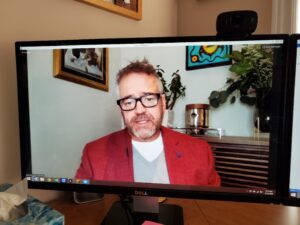How COVID-19 has changed crisis communication
By Sharon Aschaiek | Sept. 16, 2020

Six months into the COVID-19 pandemic in Canada, what have we learned about the best ways to communicate? What are the most important lessons for higher education communicators?
Yesterday, we got some answers on communication practices and impacts during COVID-19 from the International Association of Business Communicators – Toronto Chapter. Its 90-minute webinar, Keep calm & respond: lessons on COVID-19 from senior communicators, featured the following panelists:
- Gillian Howard, VP, public affairs & communications, University Health Network
- Brad Ross, chief communications officer, City of Toronto
- Jackie DeSouza, director, corporate communications, Ontario Power Generation
- Sophie Nadeau, national media lead & executive media trainer, Edelman
Here are some of their most important insights — there’s plenty here that could help your communications work for your university or college:
Communicating past fear
“Fear is a difficult thing for people. Sometimes they don’t hear,” Howard said.
To get past that, Howard’s team focused on sharing stories of solutions, such as pertinent research findings emerging from the hospital system, or how ICU nurses re-organized equipment to work more safely.
“It’s important to recognize and acknowledge people’s fear,” Ross says, but to also “share reasons for hope” by highlighting how following public health guidelines have helped bring down case numbers.
Be quick and agile
All the panelists emphasized the need for communicators to be able to think on their feet when communicating important information. For the city’s 35,000 employees, this meant quickly explaining policy changes about working from home, or measures to keep workers safe.
“It’s very important that residents and businesses have up-to-the-minute information,” Ross added, noting how his team rebuilt the City of Toronto’s homepage overnight. “The public expects an almost immediate response, and we do our organizations a disservice when we don’t…Being nimble and having a team that can respond quickly is key.”
“Don’t wait for others to tell your story, or that’s how misinformation gets out on social media,” DeSouza said. “I need communications people to feel empowered to get the message out quickly.”
“Silence is a tax on the truth,” added Nadeau. “If you don’t speak, someone else will do the talking for you.”
Keep it simple
“Much of what we do is translate research language into clear information,” Howard said. For her team, this involved getting researchers to articulate the top two or three key aspects of their COVID-19 research, so they could distill it into a clear message for the public.
“Make sure the communication is frequent, clear and transparent,” DeSouza said.
Nadeau added: “Good writing is clear, concise, accessible…Tell me what you’re trying to say in 15 words or less or I’m changing the channel.”

Visually communicate important data
At the start of the pandemic, fear ran high among employees at UHN’s eight hospital sites. To help them understand the situation at UHN and feel more at ease, Howard’s team created infographics to illustrate key information.
“People were scared we would run out of PPE, so we created visual tools showing how many days’ worth of supplies we had,” she said. “We also created visuals for the number of patients we had with the virus, and the number of staff affected, and our testing rates.”
Optimize all communication avenues
The OPG and the City of Toronto have held virtual town halls with their organizations’ leaders to keep employees informed and connected. DeSouza, who moderates, says they are extremely popular, attracting about 5,000 participants—more than half of the OPG’s workforce.
Nadeau shared Edelman’s research revealing how time spent on social media is now up across all age groups, but she noted data showing that social media are the least-trusted form of distribution for news.
This is why Ross and his team have worked overtime to populate the City of Toronto’s social media channels with accurate information about its policies, practices and results.
“Social in all forms—Twitter, Instagram, Facebook, TikTok—are mission critical in how we respond to this pandemic,” Ross said. “Make good use of your digital assets.”
The leader’s role
In a time of crisis, we have higher expectations of an organization’s leader, particularly of our elected officials.
“They need to communicate more frequently and in a way that is authentic and empathetic…and not with a finger wag or lecture,” Ross said. “This inspires confidence in employees and in the public to do what’s right.”
The shrinking divide between external and internal communications
“You can’t divorce internal and external communications anymore,” Nadeau says.
On a topic as important and relevant as covid, any information organizations share with their employees quickly goes public, she noted.
“An informed workforce is an informed public, because everyone is an ambassador,” concurs Ross. “Arming employees with good, solid information so that they can have conversations with people in meaningful way is important.”
Be part of the solution
“Now, if you’re not playing a positive role to make life better, your chance to get attention is diminished,” Nadeau said.
DeSouza’s team shared how the OPG was supporting the coronavirus response by donating masks to seniors’ homes. To empower employees to also be a part of the solution, they created a “generating kindness” page on its intranet encouraging them to make donations to their local communities.
Communication IS strategy
Finally, Nadeau said the pandemic has underscored the need for organizations to include communications executives in organizational decision making.
“Communicators should be at the leadership table,” Nadeau said. “It’s not good enough to take action as company if you can’t communicate properly—that’s just as damaging as making the wrong strategic move.”